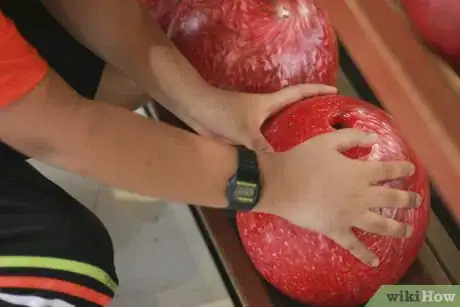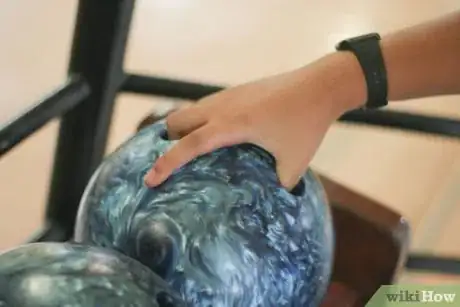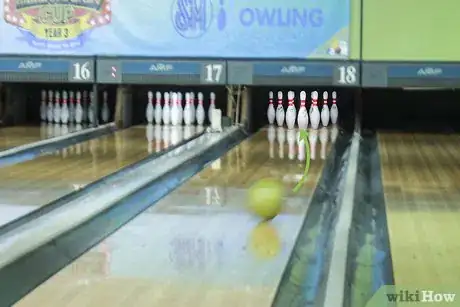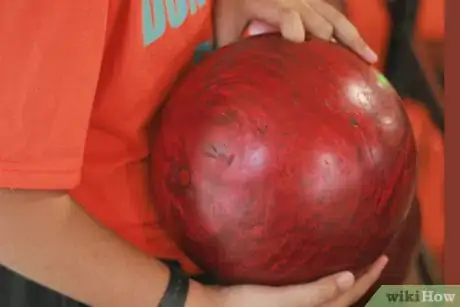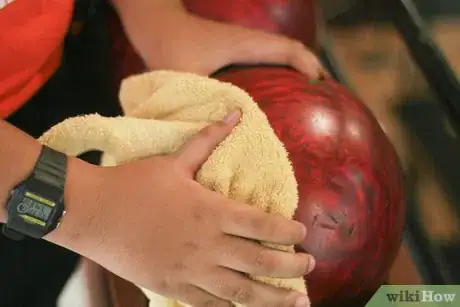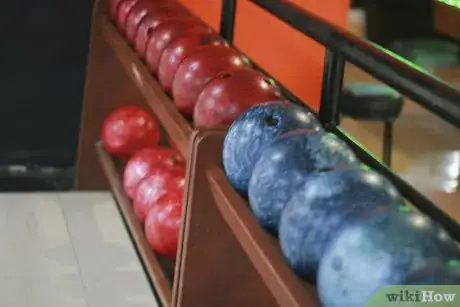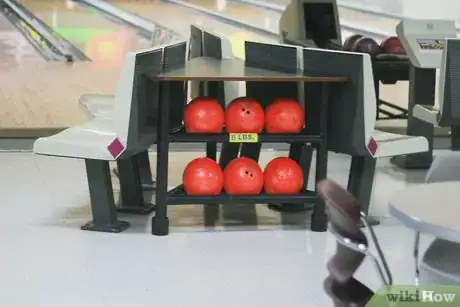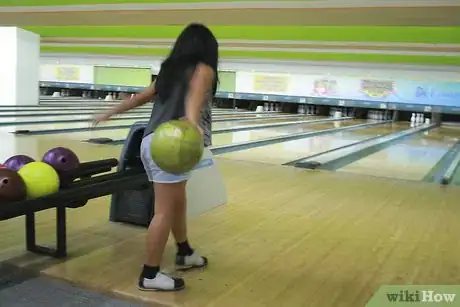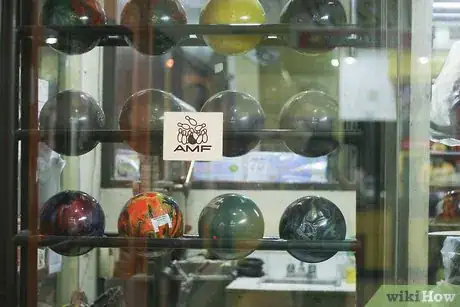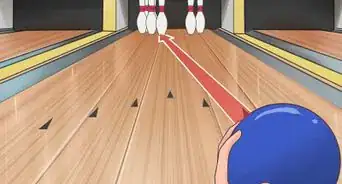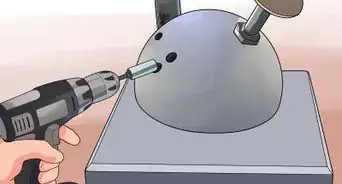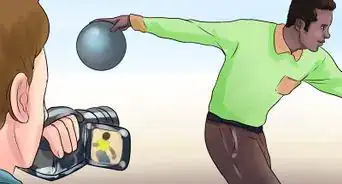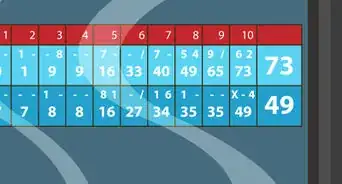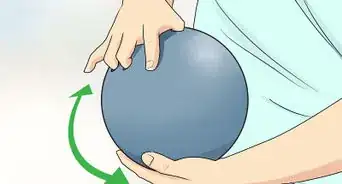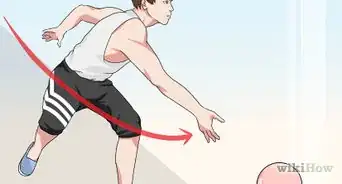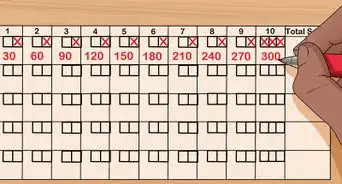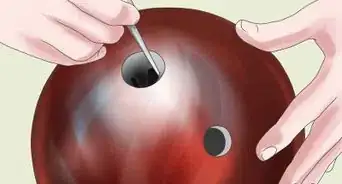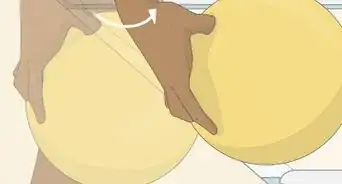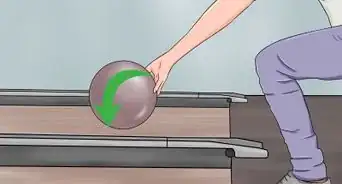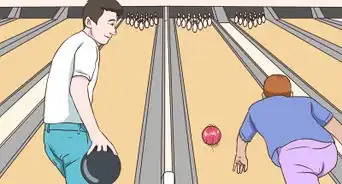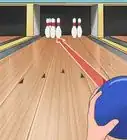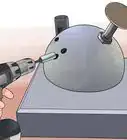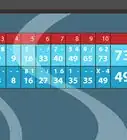This article was co-authored by wikiHow Staff. Our trained team of editors and researchers validate articles for accuracy and comprehensiveness. wikiHow's Content Management Team carefully monitors the work from our editorial staff to ensure that each article is backed by trusted research and meets our high quality standards.
There are 7 references cited in this article, which can be found at the bottom of the page.
This article has been viewed 93,275 times.
Learn more...
The modern bowling ball is much more high tech and individualized than it was twenty years ago. Different balls have extremely different levels of performance and the differences are often highly technical. Even more complicated, there isn’t t even one best type of ball; each ball is designed for a different type of player.
Steps
Picking the Right Ball for Your Body
-
1Pick a comfortable weight. Bowling balls come in a variety of weights, ranging from 6 pounds (2.7 kg) to 16 pounds (7.3 kg). Choose a ball that is heavy enough for you to effectively roll down the bowling lane without straining yourself.
- Heavier is not necessarily better. Remember, you will be tossing the ball two dozen times and what seems like a comfortable weight at first might not be so comfortable by the end of the night.
- For practice, try swinging a weight at home in much the same way that you would swing a bowling ball. If, after 23 times, your arm is tired, that weight level is too high for you. You want to have full use of arm strength through the duration of the game.
- As a general rule, you should be able to handle a bowling ball around 10% of your own body weight. Unfortunately, the poor grip quality of house balls at bowling alleys can make tossing these more strenuous. When working with a ball not specifically fitted to you, it might be necessary to use a lighter ball.[1]
-
2Find a ball that fits your fingers. Each bowling ball has holes for your thumb, middle finger and ring finger. Pick a ball with holes that allow your fingers to be inserted and removed freely, without being so loose that you lose control of the ball. Find a ball for which the distance between the holes (span) is comfortable for you. Try out several balls until you have a fit that feels comfortable.[2]
- For house balls, the size of the holes typically correlates with the weight on the ball. Heavier bowling balls feature larger holes, whereas lighter balls feature smaller holes. The limited range of options can make it difficult to find a ball that has the right weight and finger parameters for you, but you should keep on trying until you find the best fit.
- When purchasing your own ball, the pro shop should customize the span and finger holes to the size of your hand. Any quality store should fit a ball precisely to your needs without much effort on your part.
- A pro shop should also sell finger inserts, which can be useful when using other people’s balls. These can be transferred from one ball to another to improve your grip and give all of your balls a consistent feel. These have become very popular in recent years.[3]
Advertisement -
3Choose between a right-handed or left-handed bowling ball. The only difference between the two is that the ring finger is drilled 1/8 inch (3.175 mm) further from the thumb hole on a left-handed ball. The majority of balls available for rental at bowling alleys are right-handed balls. If you want to use a left-handed ball, you may need to specifically request one.
Picking the Right Ball for Your Style
-
1Choose between speed and hook. If you have trouble getting the ball down the lane at high speeds, certain ball types can improve your speed, though it will be at the expense of your hook. As a rule, balls that are shinier produce less friction and thus can move faster. Balls that have a dull appearance produce more friction and thus are easier to hook.[4]
- To hook a ball is to cause it to swing to the right or the left after tossing it. This creates the optimal trajectory for a strike, but it is a technique that typically only skilled bowlers can perform correctly
- Urethane balls are good for players who want to increase speed, but retain some hook in their throw.
- Resin, reactive, and particle balls are better for grip and hook than speed. These are good for experts who have built up a good ball speed and now want to master their hook.
- Plastic balls are good for beginners because they tend to go straight without losing control. They are not optimal, however, for either speed or hook.[5]
- At a pro shop, balls made of any substance can be polished to reduce friction, thus increasing speed and decreasing hook. [6]
- 60-80% of a ball's performance depends upon its coverstock (the hard exterior). This is the most important customizable feature of the ball.
-
2Pick a ball with the right core for your hook. Next to the cover, the most important feature of a bowling ball is its core. The heavier the core, the quicker the ball will begin to hook. A lighter core will cause the ball to hook further down the lane. There is no best core, just the core that fits throw.
- Core design varies significantly from one ball to another, making it a complex issue. You should talk to an employee at the pro shop about the core design of any ball that you are interested in.[7]
- The core is an area inside the ball that offsets the weight imbalance created by the finger holes. Because this is inside the ball, you can't actually see it and it can be difficult to understand what effect it has on your throw. That is why it is important to consult a professional about the core of your ball.
-
3Pick an appropriate ball for lane conditions. Determine whether your bowling lane is dry or oily. This will help you decide whether to pick a polished or rough ball. An oily lane will cause more skidding and, if your ball has begun to skid out of control, you should switch to a ball that is less polished. Resin, reactive, and particle balls have the grip necessary for oiled lanes.[8]
- There is no easy way to determine how the lane is oiled. You can ask the staff, but often your only real recourse is to toss the ball a few times and see how it skids.
- Typically lanes will be oiled unevenly. Often they are oiled more around the center than the edges. This will help the ball retain control before sliding into the gutter. Sometimes, the lane is oiled more in the front than the back of the lane, causing the ball to skid earlier. Thus, whether you switch to a ball that produces more friction should also be determined by whether the position of the oil is throwing off your game.
- Wipe down your ball before every throw if your lane is oily. Use a dry towel to wipe your ball.
-
4Select a color. Bowling balls are available in a wide variety of colors. Some balls are available in multiple colors, swirl patterns or even glow-in-the dark designs. The color of a ball won't physically affect how the ball travels, but a ball that makes you proud can give you the confidence you need to play a better game.[9]
Finding Your Ball
-
1Look no further than the alley. The house balls at the bowling alley are not high performance balls. Specifically, it is very difficult to get a hooked throw using one of these. However, these balls can be good for beginners because they have a lot of control and are good for straight line throws. If you’re starting out and don’t want to spend a lot of money, these can be an excellent choice.
- Even experts will occasionally throw the sort of polyester balls that are used as the house balls at bowling allies. Specifically, professional will use them for picking up spares, because when doing that an accurate, straight shot is typically preferable to a hook. Similarly, if you’re still struggling to keep the ball out of the gutter, these are probably the best balls for you.[10]
-
2Imitate other bowlers. When you watch bowling, pay attention to what professionals are using. At the alley, talk to some of the better bowlers about their bowling ball choice. Be particularly mindful of the choices of a bowler who has a style similar to yours.
- The issue with this technique is that there isn’t one best ball on the market. Finding the right ball is about finding one that fits your physique and style. So, following someone else’s lead will only work if you have similar styles.
- Alternatively, you can also ask bowlers what shop they got their ball at. This might be the most relevant piece of information, because the pro shop will be responsible for fitting your ball to your hands and should give you a lot of advice about what type fits your style. Ask around for a shop with knowledgeable staff, possibly even employees who were themselves professional bowlers.
-
3Find a good pro shop. Ask other bowlers and look online for a bowling shop with highly knowledgeable staff. Many shops will employee staff members who were themselves either successful professional or semi-professional bowlers. Because bowling balls have become so technologically advanced over recent years, it is important to have expert advice. The pro shop will also customize your grip, which can be one of the most important elements for achieving a quality game.
- As late as the 1980s, most bowling balls were fairly standardized. Today, bowling balls have different textures and core types, which have a substantial impact on play style. You should seek expert assistance when determining what type fits your style best.[11]
Warnings
- Pain in your wrist or shoulder during or after you've bowled is an indication that your ball is too heavy. Switch to a lighter ball if this happens.⧼thumbs_response⧽
Things You'll Need
- Dry towel for drying your ball if your lane is oily.
References
- ↑ http://www.bowlingthismonth.com/bowling-balls/house-balls-everything-you-need-to-know/
- ↑ https://www.myactivesg.com/sports/bowling/how-to-play/bowling-equipment/how-to-choose-a-bowling-ball
- ↑ http://www.bowlingthismonth.com/bowling-balls/
- ↑ http://www.usbcbowlingacademy.com/video/how-to-choose-a-bowling-ball-to-fit-your-needs-005549/
- ↑ https://www.myactivesg.com/sports/bowling/how-to-play/bowling-equipment/how-to-choose-a-bowling-ball
- ↑ http://www.usbcbowlingacademy.com/video/how-to-choose-a-bowling-ball-to-fit-your-needs-005549/
- ↑ http://www.bowlingdigital.com/bowl/node/2097
- ↑ https://www.myactivesg.com/sports/bowling/how-to-play/bowling-equipment/how-to-choose-a-bowling-ball
- ↑ https://www.myactivesg.com/sports/bowling/how-to-play/bowling-equipment/how-to-choose-a-bowling-ball
About This Article
To pick a bowling ball, start by finding a ball that's a comfortable weight for you to roll down the lane without straining yourself. Additionally, look for a ball with holes that are a good fit for your fingers, allowing them to be inserted easily, but not so big that you lose control of the ball. Once you’ve picked the right size and weight, make sure to choose a left-handed or right-handed ball according to your preference. However, keep in mind that the majority of balls at bowling alleys are right-handed, so ask an employee for help if you need a left-handed ball. For advice on how to choose between urethane, resin, and plastic bowling balls, keep reading.
